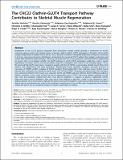| dc.contributor.author | Hoshino, Sachiko | en_US |
| dc.contributor.author | Sakamoto, Kazuho | en_US |
| dc.contributor.author | Vassilopoulos, Stéphane | en_US |
| dc.contributor.author | Camus, Stéphane M. | en_US |
| dc.contributor.author | Griffin, Christine A. | en_US |
| dc.contributor.author | Esk, Christopher | en_US |
| dc.contributor.author | Torres, Jorge A. | en_US |
| dc.contributor.author | Ohkoshi, Norio | en_US |
| dc.contributor.author | Ishii, Akiko | en_US |
| dc.contributor.author | Tamaoka, Akira | en_US |
| dc.contributor.author | Funke, Birgit H. | en_US |
| dc.contributor.author | Kucherlapati, Raju | en_US |
| dc.contributor.author | Margeta, Marta | en_US |
| dc.contributor.author | Rando, Thomas A. | en_US |
| dc.contributor.author | Brodsky, Frances M. | en_US |
| dc.date.accessioned | 2014-03-11T02:49:45Z | |
| dc.date.issued | 2013 | en_US |
| dc.identifier.citation | Hoshino, S., K. Sakamoto, S. Vassilopoulos, S. M. Camus, C. A. Griffin, C. Esk, J. A. Torres, et al. 2013. “The CHC22 Clathrin-GLUT4 Transport Pathway Contributes to Skeletal Muscle Regeneration.” PLoS ONE 8 (10): e77787. doi:10.1371/journal.pone.0077787. http://dx.doi.org/10.1371/journal.pone.0077787. | en |
| dc.identifier.issn | 1932-6203 | en |
| dc.identifier.uri | http://nrs.harvard.edu/urn-3:HUL.InstRepos:11879168 | |
| dc.description.abstract | Mobilization of the GLUT4 glucose transporter from intracellular storage vesicles provides a mechanism for insulin-responsive glucose import into skeletal muscle. In humans, clathrin isoform CHC22 participates in formation of the GLUT4 storage compartment in skeletal muscle and fat. CHC22 function is limited to retrograde endosomal sorting and is restricted in its tissue expression and species distribution compared to the conserved CHC17 isoform that mediates endocytosis and several other membrane traffic pathways. Previously, we noted that CHC22 was expressed at elevated levels in regenerating rat muscle. Here we investigate whether the GLUT4 pathway in which CHC22 participates could play a role in muscle regeneration in humans and we test this possibility using CHC22-transgenic mice, which do not normally express CHC22. We observed that GLUT4 expression is elevated in parallel with that of CHC22 in regenerating skeletal muscle fibers from patients with inflammatory and other myopathies. Regenerating human myofibers displayed concurrent increases in expression of VAMP2, another regulator of GLUT4 transport. Regenerating fibers from wild-type mouse skeletal muscle injected with cardiotoxin also showed increased levels of GLUT4 and VAMP2. We previously demonstrated that transgenic mice expressing CHC22 in their muscle over-sequester GLUT4 and VAMP2 and have defective GLUT4 trafficking leading to diabetic symptoms. In this study, we find that muscle regeneration rates in CHC22 mice were delayed compared to wild-type mice, and myoblasts isolated from these mice did not proliferate in response to glucose. Additionally, CHC22-expressing mouse muscle displayed a fiber type switch from oxidative to glycolytic, similar to that observed in type 2 diabetic patients. These observations implicate the pathway for GLUT4 transport in regeneration of both human and mouse skeletal muscle, and demonstrate a role for this pathway in maintenance of muscle fiber type. Extrapolating these findings, CHC22 and GLUT4 can be considered markers of muscle regeneration in humans. | en |
| dc.language.iso | en_US | en |
| dc.publisher | Public Library of Science | en |
| dc.relation.isversionof | doi:10.1371/journal.pone.0077787 | en |
| dc.relation.hasversion | http://www.ncbi.nlm.nih.gov/pmc/articles/PMC3813726/pdf/ | en |
| dash.license | LAA | en_US |
| dc.title | The CHC22 Clathrin-GLUT4 Transport Pathway Contributes to Skeletal Muscle Regeneration | en |
| dc.type | Journal Article | en_US |
| dc.description.version | Version of Record | en |
| dc.relation.journal | PLoS ONE | en |
| dash.depositing.author | Funke, Birgit H. | en_US |
| dc.date.available | 2014-03-11T02:49:45Z | |
| dc.identifier.doi | 10.1371/journal.pone.0077787 | * |
| dash.authorsordered | false | |
| dash.contributor.affiliated | Funke, Birgit | |


